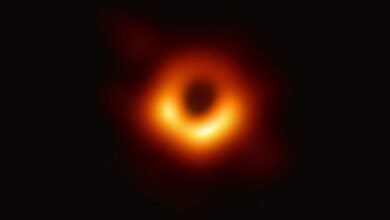Lab-Made Black Hole Glows in Groundbreaking Simulation

▼ Summary
– A 2022 experiment simulated a black hole’s event horizon using a one-dimensional chain of atoms to study Hawking radiation.
– The observed temperature rise matched theoretical predictions, suggesting particle entanglement across the event horizon generates this radiation.
– Hawking radiation was only thermal under specific conditions, indicating it depends on spacetime warping due to gravity.
– This research could help reconcile general relativity and quantum mechanics by studying quantum gravity in controlled settings.
– The simple experimental model allows for broader exploration of quantum gravity and curved spacetime in condensed matter systems.
In a remarkable scientific breakthrough, researchers have successfully created a laboratory simulation of a black hole that emits a telltale glow, potentially illuminating one of physics’ most elusive phenomena. This analog black hole provides crucial insights into Hawking radiation, a theoretical emission predicted to occur at the edge of real cosmic black holes. By constructing a one-dimensional chain of atoms to mimic a black hole’s event horizon, physicists observed radiation patterns that align with Stephen Hawking’s revolutionary predictions from 1974.
The experiment’s design cleverly used the atomic chain as a pathway for electrons to jump between positions. By adjusting how easily these quantum leaps could happen, the team effectively engineered a synthetic event horizon. This artificial boundary disrupted the electrons’ wave-like behavior, producing a temperature increase consistent with theoretical models for Hawking radiation. The thermal signature only appeared when portions of the atomic chain extended beyond this simulated horizon, suggesting that particle entanglement across the boundary plays a fundamental role in generating the radiation.
This discovery carries profound implications for resolving one of modern physics’ greatest challenges—the conflict between Einstein’s general relativity and quantum mechanics. General relativity describes gravity as the curvature of spacetime, while quantum mechanics governs the probabilistic behavior of subatomic particles. Black holes represent where these two theories dramatically collide, making them ideal natural laboratories for studying their potential unification.
The research team, led by Lotte Mertens at the University of Amsterdam, noted that the simulated Hawking radiation demonstrated thermal properties only under specific conditions. The radiation appeared thermal within certain hopping amplitude ranges and when simulating what physicists call ‘flat’ spacetime. This indicates that Hawking radiation might not always exhibit thermal characteristics, particularly when spacetime curvature changes due to gravitational effects.
What makes this approach particularly valuable is its simplicity and reproducibility. Unlike studying actual black holes, which involves extreme and unpredictable dynamics, this laboratory model provides a controlled environment for investigating quantum gravitational phenomena. The system’s straightforward design means it can be adapted across various experimental platforms, opening new avenues for exploring how quantum mechanics interacts with gravity and curved spacetime.
The researchers emphasized that their work establishes a practical method for examining Hawking radiation’s emergence without the complications inherent in real black hole formation. This experimental accessibility could accelerate progress toward understanding quantum gravity—the long-sought theory that would unite general relativity with quantum mechanics.
As physicists continue to refine these black hole analogs, each iteration brings us closer to comprehending the universe’s most fundamental workings. The ability to recreate and study cosmic phenomena in laboratory settings represents a significant step forward in theoretical physics, potentially unlocking secrets about spacetime, quantum fields, and the nature of reality itself.
(Source: Science Alert)
